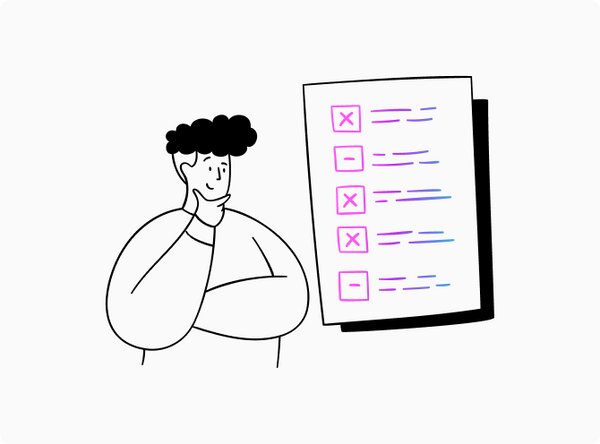
Many startups want to come up with the best product ever when they start working on MVPs. While that's a natural desire for any company to deliver a product of the highest quality, let's not forget about the main idea behind an MVP, which is to test the core hypothesis of the product and see if there is a market need for it.
This is why it's important to keep the MVP simple and prioritize features that are most important to its success. Read on to find out which minimum viable product (MVP) features to choose and what methods to follow in that regard.
Choosing an MVP Feature Set: Main Do's and Don'ts
When deciding on MVP features keep in mind the definition of the concept of a minimum viable product. An MVP is a product with the least amount of features and functionality necessary to generate customer feedback and measure the success of a product.
In other words, MVPs should include a minimum set of features, and be launched fast and within manageable timeframes. You don't want the development of your MVP to get stretched over months and years only to find out that there might be no 'product-to-market' fit at all.
How Many Features Does an MVP Need
When deciding on the 'minimum MVP features' it's necessary to remember that the word 'minimum' is relative. In some cases, an MVP may have only one core feature, while in other cases, it may have several. To narrow down the scope for you, on average MVPs include 2 to 4 main features. However your set of MVP features will still depend on the market, the user problem that you want to deal with, and the project budget.

Choosing Features for an MVP Step-By-Step
Get to know your target audience (TA)
Getting to know your TA is crucial for the success of your MVP. Here you want to conduct initial market research to gain insights into the demographics, behaviors, and interests of your potential users. You can collect necessary information via surveys, interviews, focus groups, etc. Analyze data from social media, forums, and other online platforms.
Once that's done, create user personas that represent your target audience. A user persona is a fictional character — or collective image — that represents your target audience and helps you better understand their needs and expectations.
Define their biggest pain points
Pain points are the areas in which your target audience has a problem or need. They are the reasons why customers are looking for a solution in the first place. The pain points can also be related to the use of a particular product, service, or technology.
By analyzing the data collected during the market research you can identify common problems or issues that your target audience experiences. Identify what worries your potential users the most, what their motivations are, and what they struggle the most with.
Once you have identified the pain points, prioritize them to define the biggest ones and focus on those in your MVP. Note also that customers' preferences — and pain points — may change over time, so it’s necessary to keep an eye on market trends and the current needs of your TA.
Figure out how your product can help address these problems
At this step, you need to consider what features would be most valuable to include in an MVP. Ask yourself a few basic questions regarding your target audience and the possible ways of using your product to determine the best MVP features — those that your target customers will find most valuable.
- What features do we need to solve the biggest pain point(s) of our users?
- What is the minimum set of features that will provide the most value to our users?
- Which features are critical for our MVP, and which can be added later?
- How can we simplify the MVP to make it easier to use and understand for the users?
- How can we make the MVP more appealing and engaging to the target audience?
- What are the technical limitations and resources we currently have for developing the MVP?
- How can we ensure that our product stays relevant to our users in the mid- and long-term perspective?
Research your competition
Identifying who your competitors are is as important as knowing your target audience for several reasons. For one, you can understand what your competitors are offering and what their unique selling points are. This information can help you differentiate your MVP from others in the market and identify MVP core features that may give you a competitive advantage.
You can also avoid making the same mistakes as your competitors. By studying their weakest and strongest points, you can learn what works and what doesn't in the market. This information can help you to develop an MVP that has a higher chance of success.

What Features Should an MVP Not Have
Expensive features
Developing expensive features consumes a lot of time and resources, which can be a significant financial burden for a startup. Given that MVPs are normally designed to test the market and validate assumptions with minimal investment, adding expensive functionality can generate a significant loss if the product doesn't meet market expectations. This is why when it comes to MVP development, all functionality should be created quickly (relatively speaking) and at a minimal cost.
Complex integrations
Complex integrations with other systems or services can be time-consuming and expensive to integrate. Since they take longer to develop and implement, they may eventually hinder the MVP's ability to deliver value to users quickly, thus delaying the feedback loop. With an increased level of complexity, it may become harder to test and debug an MVP.
While MVPs need to be developed (and updated) quickly, the extended development times increase the risk of potential failure. That's why it's vital to keep MVP's structure simple at the early stages.
'Not necessary' ones
Adding 'not necessary' or secondary functions to an MVP can cause the project's scope to creep, which can make it harder to develop the MVP within projected timeframes. Including secondary features in an MVP may also distract early users from the core functionality of your product, leading to the latter not being able to meet their needs and solve their specific problem. Aside from that, secondary features add to the complexity of MVP, making it more challenging for the development team to keep up with updates and product testing.

How to Prioritize Features for MVP in the Most Effective Way
Now let's move from theory to practice and see which prioritization techniques you can use when choosing features for MVP. It's important to note though that each method has its advantages and limitations, and the final choice should depend on the specific needs and requirements of your product.
Numerical assignment method
In this method, potential features get assigned a numerical score based on their importance and priority. Each feature is given a score from 1 to 10 based on the urgency, feasibility, and impact they can produce. Then, all the features are ranked based on their total score.
Effort and impact technique
This technique involves assessing each feature based on the potential value that it may bring to the product and the effort — the amount of resources — needed to implement it. Consequently, features that produce high impact and require low effort are prioritized higher compared to those that bring low impact and require high effort.
Bubble sort technique
Here, features get sorted based on their importance and urgency. The most critical and urgent features are placed at the top of the list, while less important ones are placed at the bottom. This method can be useful when you have a limited amount of time or money available to develop the MVP.
Kano model
This method categorizes features into three groups: Threshold, Performance, and Excitement features. Threshold or must-have features are those considered mandatory for the project. These are the features that help the product meet user needs. Performance features are those that improve user satisfaction, and the Excitement category encompasses features that provide a unique competitive advantage for the product and help to produce a wow effect.
User story mapping
This technique involves putting together user stories and identifying which features the product needs to get the user to the final point in each case scenario. Features get grouped based on their importance to the user and the user's journey and then prioritized based on the user needs and available resources of your MVP.
Opportunity scoring
During opportunity scoring, the team assesses features based on their potential value and the opportunity they provide. They do it by directly communicating with the prospects and asking their opinion on the similar functionalities of some already existing products. The goal here is to assess the level of satisfaction and importance of those MVP features examples. The most promising features would be those that have high importance scores and low satisfaction scores (meaning they are currently overlooked by product providers).
Speed boat method
The speed boat method involves creating a visual representation of features and their impact on the product. The features are placed on a 'speed boat,' with the boat representing the product and the features representing either anchors that slow down or boosters that speed it up.
The team assesses the impact of each feature on the product's success and places them on the boat accordingly. Those features that have the most significant impact on the product's success are placed closest to the front of the boat — meaning they need to be developed in the first place.

Create Your MVP With Lunka.tech
If you are looking for a professional software development company to create an MVP, look no further than Lunka.tech. We provide secure and scalable solutions that cater to the unique business needs of our clients. Digital products that we develop utilize the latest technologies and provide unique experiences to their audiences.
We always stay 100% transparent in our work and share the examples of solutions we develop in our portfolio. Whether you are looking to create a new product or update the existing one, we have the relevant expertise and resources to help you do that.
Final Thoughts
In summary, there is no one-size-fits-all answer to the question of how many features an MVP should have. The required MVP features list will depend on the product, the target market, the goals and objectives, and other factors such as desirable user experience and available project resources.
Ultimately, the goal of the developers is to find the balance between providing enough features for users to grasp the product’s value, without overburdening the MVP with unnecessary functionality.
We hope that you find this information useful. If you want to know exactly what MVP features are needed for your product or how to prioritize MVP features, reach out to us for a free consultation! Our managers will provide you with all the necessary information and estimates for your project development!
FAQ
How many features does an MVP need?
The number of features in an MVP could vary widely, from a single feature to a few key features depending on the specific product and the problem of the target audience it is trying to solve. The emphasis should be put on creating an MVP that provides enough value to attract early adopters and get their feedback.
What is the first step to identifying MVP features?
The first step to identifying MVP features is to define the problem or need that your product is intended to address. This involves understanding your potential clientele, their pain points, and the problem that they are trying to cope with. Figure out what your target audience is looking for at the moment and provide them with the relevant MVP feature set.
How to decide which features should be included in MVP?
When deciding which features to add to an MVP, the key here is to keep it simple. You don’t want to include too many features, as this can make the product complex and difficult to launch. Identify which features are essential for your users and start working on those first.
Why should I build an MVP in the first place?
Building an MVP allows you to test market assumptions without investing too many resources in the development process. An MVP helps to reduce the risks of failure, get customer feedback at the early stages and learn from it.


